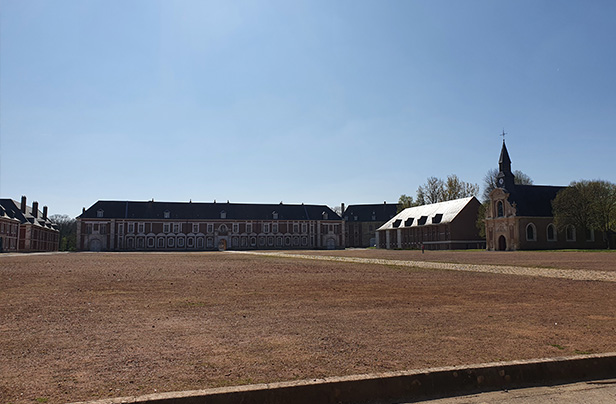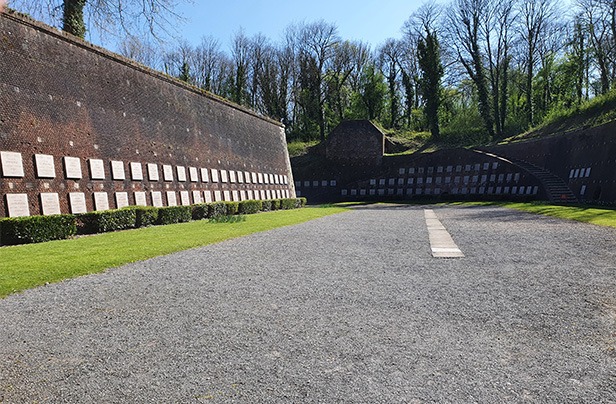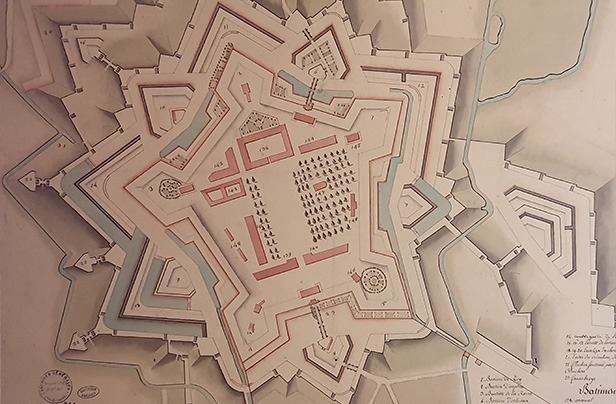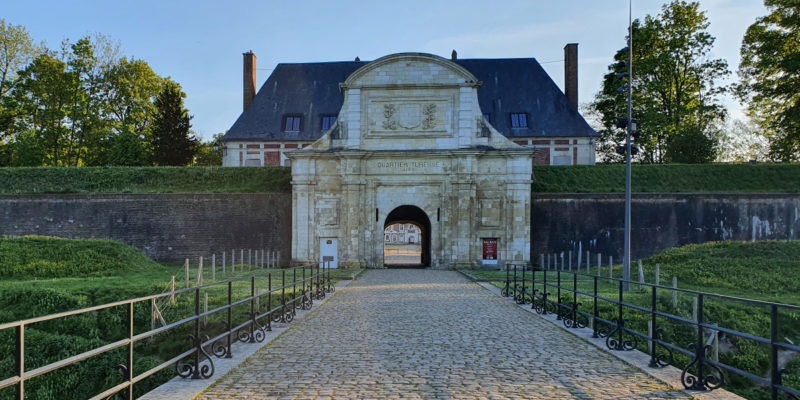Built by Sébastien Le Prestre de Vauban on the orders of King Louis XIV and François Michel Le Tellier, the Marquis de Louvois, who reorganized the French army in the 17th century, the political powers that be considered the best location for the fortress. Suggestions included the Ronville gate, Baudimont, between the Amiens and Hagerue gates, or near the Grand’Place. Finally, it’s in the area that follows the rue d’Amiens that you’ll see the complex, near the Governor’s garden and the polygon on boulevard Vauban. Work began in 1668 and was completed just two years later, for a complete structure covering 72 hectares. Demilitarized, the “Citadelle d’Arras” is now used by homes, businesses and local authorities, as you can see at the end of this article.
La Citadelle, from military history to Unesco World Heritage listing
When you enter the citadel through the gateway to the Turenne quarter (the picture on the front page of this issue), you can quickly see the moat that once surrounded it. At the end of the 20th century, as you passed through the gate, a military guard was waiting to check you in, as the barracks, symmetrical according to Vauban’s plans, still housed garrisons (in particular, the 601st road traffic regiment). It’s striking how the site is organized around the Place d’Armes. There are cannon-shaped columns, red brick buttresses and relatively dense vegetation around the edges.
In fact, the Citadelle is at the heart of the green space of the High Fountains.

The Place d’Armes at the Citadelle, with the Chapelle Saint-Louis on the right
The cobblestones you can tread lead you first to the Chapelle Saint-Louis, the oldest building in Arras (even older than the house housing the Hôtel des 3 Luppars on the Grand’Place). With its scrolled gables, this chapel is reminiscent of the architecture of the town’s squares. Visits are free of charge.
Never attacked, the Citadelle d’Arras was described as a “useless beauty”.
In the 18th century, particularly from 1715 onwards, the underground passages of the Arras Citadel were used as prisons. If you take a walk around the ramparts, you’ll see passageways leading to these subterranean tunnels, which should be avoided.
The wall of the shootings
Much later, during the Second World War, 218 people were shot between August 1941 and July 1944. There are commemorative plaques at the site known as “Le mur des fusillés“. It is commemorated every year by the people of Arrage on May 8, 1945. Resistance fighters have their plaque there, such as Julien Hapiot, a communist militant who organized the attack on German vehicles at Vimy in September 1940, but also, with others, of the Nord-Pas-de-Calais miners’ strike which lasted from May 27 to June 10, 1941. You can also see the plaque bearing the name of Alfred Touny, a companion of the Liberation who, along with other members of the Resistance, created the Organisation Civile et Militaire (OCM) and was a member of the Conseil National de la Résistance. At the entrance to the Mur des fusillés, you’ll see the following inscription:
In Memoriam. 218 patriots of all origins were shot between 1941 and 1944 in the ditches of the Arras Citadel. You who come to this place, keep in your memories the memory of their martyrdom.

The wall of the shootings in Arras
The Citadelle of Arras is a French and World Heritage Site
With the military having left the site in 2008 (1,500 soldiers may have lived there at the height of the barracks), the town and the Communauté Urbaine d’Arras in particular had to take decisions to rehabilitate the site. Although the Arras Citadel has been a partially listed monument since 1920 and 1929, it was only in 2008, when the government decided to disband the 601st RCR, that the Arras Citadel was listed as a UNESCO World Heritage Site. The citadel was fully listed as a Monument Historique in 2012. Today, the citadel is entirely civilian and, over the years, has become an economic hub, as shown below.

Map of the Citadel at the Arras museum
The Arras Citadel today
Returned to civilian use in 2008, the Citadelle d’Arras has been the subject of much thought and reflection in terms of its rehabilitation by the CUA. Today, the CUA has its headquarters there, but a number of activities have been set up to give this vast space a new lease of life.
In particular, there are a number of hubs, including :
A digital hub
On your way to the Arras Citadel, take a look at the Foyer Numérique, located in one of the rectangular buildings near the exit leading to the Mur des Fusillés. Here you’ll find a number of communications and IT companies.
Nearby, in a former powder magazine, is a data center. It was built by the company Décima. This is a first in terms of technology, as it involves the rehabilitation of a site whose original purpose was totally different.
Administrations and companies
Next to the digital foyer, another building is home to a number of local administrations and associations.
These are open to the public by appointment. Here we find an economic hub, but sometimes also a social one. At La Citadelle, there’s an integration company and a business hotel. Catering is also present, with several local players in the field. There’s also a honey factory and a goat farm, in keeping with the natural surroundings.
Various activities
The Arras Citadel is the venue for the Main Square. It’s also and above all a place for strolling and a jogger’s paradise.
The town’s cultural agenda also includes a number of activities. Finally, a tree adventure course is also available to visitors, close to the CUA site.
Geographical location of La Citadelle
A place of passage, including for those taking the route to Santiago de Compostela (and the Via Francigena), the Citadelle is organized around the Place d’Armes, to the southwest of the city center:
It’s the ideal place to take a family stroll and discover a heritage dating back over three hundred years.
X.D.
